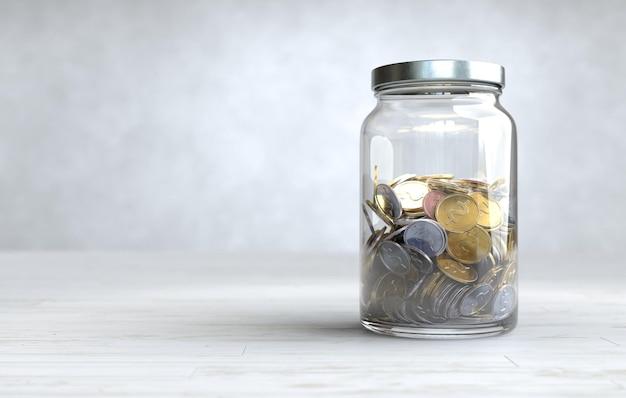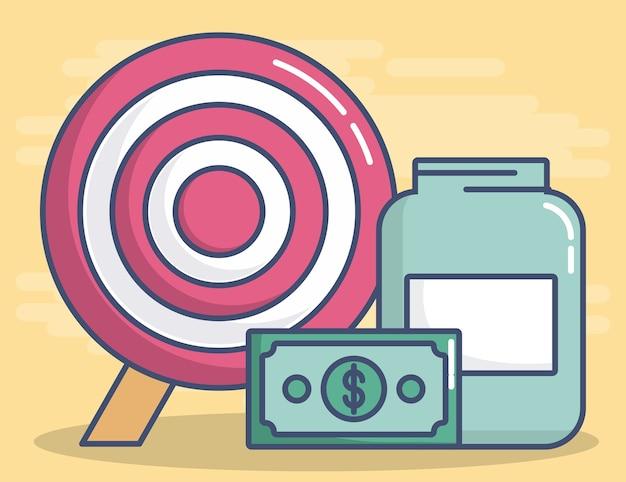Allowance jars have become popular tools for teaching children about money management. Gone are the days of stashing loose change in a classic piggy bank. Today, we’ll explore the concept of allowance jars and how they can help instill good financial habits in kids. From understanding the three jar allowance system to tips on choosing the right jar lids, we’ll cover it all. So let’s dive in and discover how to set kids up for a lifetime of financial success!
Allowance Jars: A Fun and Effective Way to Teach Financial Responsibility
What are Allowance Jars
Allowance jars, also known as money jars or piggy banks, are a clever method to teach kids about budgeting and financial responsibility. By dividing their allowance into different jars, children learn valuable skills such as saving, spending, and giving.
The “Save” Jar: A Piggy Bank with a Purpose
The first jar, often represented by a cute piggy bank, is the beloved “Save” jar. This jar is where kids can stash away a portion of their allowance for future goals. Whether it’s saving up for a new toy, a bike, or even a trip to Disney World, kids learn the power and satisfaction of delayed gratification.
The “Spend” Jar: Treat Yo’ Self!
Next up, we have the “Spend” jar – every child’s dream come true! This jar is a piggy bank of possibilities, containing funds that can be used for small purchases or treats. It teaches children the value of money and encourages them to make wise decisions about their spending, ensuring they don’t blow it all on one toy or pack of candy.
The “Give” Jar: Sharing is Caring
Last but not least, we have the noble “Give” jar. This jar cultivates generosity and empathy in children by encouraging them to set aside a portion of their allowance for charitable acts. It’s a beautiful way to teach children the joy of giving back to their community and helping those in need.
The Perks of Allowance Jars
Allowance jars offer a plethora of benefits beyond teaching financial skills. They empower children to make decisions about money from an early age, instilling a sense of responsibility and independence. By visualizing their savings and witnessing how their contributions increase over time, kids develop a stronger understanding of the value of money.
Getting Creative with Allowance Jars
You can take allowance jars to a whole new level of fun and engagement by customizing them to your child’s interests. Use themed jars like a treasure chest for saving, a toy car for spending, and a heart-shaped jar for giving. Decorate them together, making the process exciting and personalized.
Teaching Life-Long Financial Habits
Allowance jars are not only about teaching kids money management skills; they also lay the foundation for a lifetime of healthy financial habits. By starting early, children develop an understanding of the importance of saving, wise spending, and giving, setting them on a path towards financial success in adulthood.
Wrapping Up
Allowance jars provide an enjoyable and effective way to impart financial education to children. By dividing their allowance into different jars, kids learn the essentials of budgeting, saving, spending, and giving. This approach not only teaches valuable skills but also helps children develop a positive and responsible relationship with money, fostering habits that will benefit them throughout their lives. So, let’s dust off those jars and get our kids on the road to financial success!
Piggy Bank: Saving Money with a Twist
A Fun Twist on Traditional Savings
Who says saving money has to be boring? Introducing the piggy bank – the ultimate companion in your money-saving journey. But hold your horses, because this is not your ordinary piggy bank. It’s the piggy bank with a twist!
Smart Saving with a Stylish Oink
Forget about those plain, old jars or dusty envelopes for your spare change. The piggy bank is here to add some personality to your savings routine. With its cute snout, curly tail, and irresistible charm, saving money has never been so stylish. Plus, the added bonus of having a constant companion who greets you with an enthusiastic “oink” every time you drop in a coin is just priceless!
Breaking the Piggy Bank Stereotypes
Gone are the days when piggy banks were only associated with children. These days, everyone can have their own piggy bank, regardless of age or gender. Who wouldn’t want a cute pig sitting on their shelf, cheering them on as they save towards their goals? It’s like having a personal cheerleader in the form of an adorable, ceramic porker.
Saving for Your Dreams, One Trot at a Time
Whether you’re saving up for a lavish vacation, that dream gadget, or simply building an emergency fund, the piggy bank has got your back. It’s the perfect vessel to house your spare change and watch your savings grow. As each coin drops into your piggy’s belly, you’ll feel a sense of accomplishment and motivation to keep saving.
Piggy Bank Accountability
Unlike other saving methods, the piggy bank allows you to physically see your progress. There’s something satisfying about watching your piggy fill up with coins, knowing that you’re getting closer to your financial goals with each deposit. It’s a tangible reminder of the value of your hard-earned cash, and a gentle nudge to keep those pennies rolling in.
Fun Coin Counting Adventures
When the time comes to cash in your piggy bank, get ready for a thrilling coin counting adventure. Pouring out the contents and sorting through the colorful assortment of coins can be a delight in itself. And who knows? You might even discover a rare coin or two that will make your savings soar to greater heights.
So, why settle for a boring old jar when you can have a piggy bank that brings joy and excitement to your saving journey? With its cute looks and quirky charm, the piggy bank is a delightful and entertaining way to save money. So go ahead, break those piggy bank stereotypes and embark on a fun-filled savings adventure! Oink, oink!
Jars Guidelines
Why Jars Guidelines are Important for Your Allowance
So, you’ve decided to jump on the allowance jar bandwagon, huh? Well, buckle up, my friend, because it’s time to lay down some jars guidelines to help you rock this whole money management thing. Trust me, it’s way more fun than adulting!
The Jar Hierarchy: Who’s the Boss
Now, before you start tossing your hard-earned cash into random jars like a thrift store shopaholic, let’s establish a hierarchy. Think of it as a little family of jars, each with its own personality and role.
Big Daddy Jar: Savings
This is where the magic happens, folks. The saintly Big Daddy Jar is all about long-term goals, like that designer bag you’ll flaunt when you’re a high-powered CEO. Treat this jar like royalty, feeding it with a chunk of your allowance. Watch your savings grow and feel like a financial wizard.
Chillaxin’ Jar: Fun
Who says finance can’t be fun? Not us! Meet your trusty Chillaxin’ Jar, the ultimate stress buster. This jar is all about instant gratification and treating yourself. Want that new video game or a spontaneous ice cream binge? The Chillaxin’ Jar is your partner in crime!
Giving Back Jar: Giving
Life isn’t just about you, my friend. We’re here to make the world a slightly better place, starting with our allowance. The Giving Back Jar has your back when you want to support a good cause, donate to your favorite charity, or Rescue McNuggets (yes, those poor abandoned chicken nuggets need love too).
Feeding the Jars: The Do’s and Don’ts
Do: Prioritize But Keep it Real
Feed your Big Daddy Jar first. Saving is a priority, but don’t forget to set aside some dough for fun and philanthropy too. Balance, my friend, is the key to success.
Don’t: Rob Peter to Pay Paul
Resist the temptation to borrow from other jars when one category looks extra tempting. Remember, we’re not running the Federal Reserve here. Stick to your allocations and avoid awkward conversations with your jars when they feel neglected.
Do: Get Creative With Your Jars
Make your jars stand out! Decorate them, give them names, or even play some funky tunes for them while you count your coins. The more personality, the better. Your jars aren’t just containers; they’re your trusty sidekicks on this financial journey.
Don’t: Let Your Jars Collect Dust
Don’t leave your jars alone collecting dust bunnies in the corner. Regularly visit them, assess your progress, and make adjustments as needed. Your jars need love, attention, and a little fun too!
Wrapping Up
Now that you’ve got these guidelines down, you’re ready to conquer the world of jars like a boss. Remember, money management doesn’t have to be boring or stressful. Embrace the quirks and enjoy the journey. With your allowance and those adorable jars, you’re well on your way to becoming a financial superstar!
How to Measure for Jar Lids
So, you’ve got your jars all lined up, ready to be filled with the delectable concoctions you plan to whip up in your kitchen. But hold on a minute, before you get all carried away with your culinary genius, you need to make sure you’ve got the right lids for those jars. Because trust me, nothing puts a dampener on your homemade strawberry jam like a lid that just won’t stay put.
Getting the Right Fit with the Right Tools
1. Rulers Are Our Friends
First things first, grab yourself a ruler. None of that flimsy plastic stuff either, go for the good ol’ reliable metal ruler. It’s the boss of all rulers, really. Place it on top of your jar and measure the diameter. Simple, right? Now you know the size of lid you need to be huntin’ down.
2. Flexible Friend, aka Tape Measure
If you’re dealing with a jar that doesn’t have a perfectly round opening (because let’s face it, life can get messy sometimes), a good ol’ flexible tape measure will be your savior. Wrap it around the top of the jar to get an accurate measurement. Make sure you’re not pullin’ it too tight or lettin’ it hang loosely. We’re looking for a snug, comfortable fit here, folks.
Finding the Perfect Lid
1. The Lid “Gimme Gimme” Technique
Now that you’ve got your measurements down, it’s time to track down the perfect lid. Head on over to your local kitchen supply store and get ready to be amazed at the array of lids on offer. Use those measurements to narrow down your options and find the lid that screams “I’m the one for your jar!” Don’t be afraid to try a few on for size to ensure a snug fit.
2. The Lid Compatibility Dance
If you’re feeling particularly adventurous and want to dive into the world of online shopping, there are some nifty tools out there that can help you find the perfect lid match for your jars. Websites and apps that specialize in jar-lid compatibility can be a lifesaver, saving you from the disappointment of receiving lids that just don’t fit. So strap on your virtual shopping boots and get exploring.
The Final Verdict
Now that you’re armed with the knowledge of how to measure for jar lids, you can confidently embark on your journey to sealing deliciousness in a jar. Remember, accuracy is key, but don’t be afraid to have a little fun along the way. Happy lid-hunting!
What is the 3 Jar Allowance
Introducing the 3 Jar System
So, you’ve heard about this magical concept called the 3 jar allowance, but what on earth is it? Well, my friend, let me break it down for you. Picture this: you have three jars sitting on your shelf, each with a purpose and a specific allowance. It’s like having your very own mini bank at home!
The Spend Jar: Giving in to Temptation
Ah, the spend jar, the one we all secretly love the most. This jar is all about satisfying those instant gratifications and giving in to the pleasures of life. Whether it’s grabbing your favorite latte or splurging on that new pair of shoes you’ve been eyeing, the spend jar is there to indulge your desires. Just remember to spend wisely and not blow it all on the latest tech gadgets.
The Save Jar: Building for the Future
Now, let’s talk about the save jar – the responsible one of the bunch. This jar is all about setting aside some cash for the future. It’s like having your own personal nest egg. Think of it as a little squirrel storing acorns for the winter. You never know when you’ll need that extra bit of cash for emergencies or that dream vacation you’ve been drooling over. So, don’t underestimate the power of the save jar; it’s your ticket to financial security and fun adventures.
The Give Jar: Spreading the Love
Last but not least, we have the give jar – the warm and fuzzy one. This jar is all about giving back to the world. Whether it’s donating to your favorite charity or buying a cup of coffee for the person in line behind you, the give jar is there to spread some love and kindness. Remember, it doesn’t have to be a grand gesture; even the smallest act of giving can make a big difference in someone’s life.
The Beauty of Balance
Now that you know the three main players in the game, you might be wondering how to distribute your allowance among them. Well, my friend, that’s the beauty of the 3 jar allowance – it’s all about finding the right balance. You get to decide how much goes into each jar based on your needs, goals, and values. Just remember to be realistic and stick to your allocations. It’s like creating your very own financial ecosystem.
So, there you have it – the 3 jar allowance system in all its glory. With the spend, save, and give jars, you can manage your allowance like a boss. Remember, it’s not just about the money; it’s about cultivating healthy financial habits and making a positive impact on the world. So, go ahead, embrace the 3 jar allowance, and watch your piggy bank grow while spreading a little joy along the way. You got this!
How to Add Dependency Jars in a Jar
So, you’ve decided to dive into the world of programming to create your own Java application. Congrats, you’re about to unlock a door to a world filled with endless possibilities! But wait, what’s this about dependency jars? How do you add them to your jar? Fear not, my friend, for I am here to guide you through this perplexing task with a sprinkle of humor along the way.
What in the World are Dependency Jars
Before we dive into the nitty-gritty of adding dependency jars, let’s take a quick detour to understand what they are. Think of a jar as a fancy lunchbox that holds all your application’s files. A dependency jar, on the other hand, is like a scrumptious snack that your application craves to function properly. In simpler terms, a dependency jar contains code that your application needs to run smoothly.
Getting Started with Adding Dependency Jars
Now that we’re on the same page, let’s tackle the all-important question: how do you actually add these dependency jars to your jar? It’s a piece of cake, my friend! First, you’ll need a build tool like Maven or Gradle – think of them as your trusty kitchen assistants.
Maven to the Rescue
If you’re using Maven, open your pom.xml file (the recipe book for your project) and head over to the
Gradle, the Cool Kid on the Block
If Gradle is more your style, open your build.gradle file (the trendy sibling of pom.xml) and find the dependencies block. This is where you’ll unleash your inner mixologist! Simply add the required jars as dependencies within the dependencies block, and Gradle will shake it up to create a delicious concoction of jars inside your own jar.
All Set, Let’s Build!
With your dependencies snugly added to their designated build tools, it’s time to build your jar. Whether you’re using Maven or Gradle, simply hit that build command and watch the magic happen. Your build tool will compile your code, gather the required dependency jars, and voila! You now have your very own jar with all the necessary ingredients for your application to shine.
Wrapping It Up
Adding dependency jars to your jar may initially sound like a daunting task, but with the right build tool by your side, it’s as easy as following a recipe. So go forth, my fellow developer, and create your masterpiece with confidence. Happy coding!
How Much Should Kids Get for Allowance
The Great Allowance Debate
When it comes to deciding how much allowance to give your kids, it can feel like walking a tightrope. Too much, they might grow up spoiled. Too little, they might not feel valued. So, what’s the right amount? Let’s dive into the great allowance debate and find out!
A Penny for Their Thoughts
Asking your kids how much they think they should get for allowance is like opening Pandora’s box of wild imagination. They’ll come up with wild figures like a million dollars a week to buy all the toys in the universe or a bazillion dollars to finance their future dreams of becoming a superhero. Take their suggestions with a pinch of salt – or in this case, a penny for your thoughts!
Age Matters
The amount of allowance you give your kids should depend on their age. A six-year-old doesn’t need as much money as a teenager who has discovered the magic of online shopping. Consider giving younger kids a modest amount, enough to teach them the value of money, while ensuring older kids have a reasonable sum to manage their growing expenses.
The 50-40-10 Rule
One approach to determining allowance is the 50-40-10 rule. Encourage your kids to split their allowance between saving, spending, and giving. For example, they could save 50% for future goals, spend 40% on things they want or need, and donate 10% to a charity of their choice. This not only teaches them financial responsibility but also nurtures compassion.
Let the Chores Begin!
If you want your kids to understand the connection between hard work and money, tying allowance to chores is a great idea. Assign age-appropriate tasks and attach a monetary value to each. This way, they’ll not only earn their allowance but also learn the importance of contributing to the family and household chores.
Quality over Quantity
Remember, it’s not just about the amount of money kids receive; it’s about how they manage it. Instead of focusing solely on the amount, emphasize the value of money and the importance of making wise choices. Teach them to budget, save up for bigger purchases, and develop good spending habits that will benefit them in the long run.
While there is no one-size-fits-all answer to the question of how much allowance to give kids, finding a balance between teaching them the value of money and ensuring they have enough for their needs is key. The amount can vary depending on factors like age, chores, and personal financial goals. By combining financial education with practical experiences, kids can grow up to be responsible and savvy with their money. So, go ahead, give them a fair allowance, and watch them flourish!
How Much is a 13-Year-Old Allowance per Week
Setting the Stage: The Age-Old Question
Alright, folks, buckle up because we’re diving deep into the mysterious realm of allowances. And today, we’re tackling the burning question that parents and kids alike ponder: “How much is a 13-year-old allowance per week?” Are you excited? I know I am!
The Great Allowance Conundrum
Now, before we jump into the specifics, let’s lay down some ground rules. Allowances, my friends, are a tricky business. It’s like trying to navigate a labyrinth without a map or a GPS. But fear not! We’ve got you covered.
A Balancing Act: Money vs. Responsibility
First things first, let’s talk numbers, baby! While there isn’t a magical figure etched in stone, the general consensus, or what I like to call the unwritten “Allowance Bible,” suggests that a 13-year-old’s weekly allowance should hover around the $10 to $20 range.
Why the Range, You Ask
Well, young Padawan, the range depends on various factors. For instance, where you live can make a difference. If a candy bar costs you a few pennies, you may want to lean toward a slightly lower allowance. On the other hand, if you’re residing in the land of gourmet ice cream where unicorns roam, a slightly higher allowance might be in order.
The Task-to-Cash Ratio
Now, don’t go running off to demand a higher allowance just yet! Remember, with great allowance comes great responsibility. (I apologize for the terrible Uncle Ben impersonation.)
Chores, Chores, Chores
Here’s where things get interesting. Perhaps you’ve heard tales of chores being tied to allowances. Now, some parents believe that chores should be a part of everyday life, contributing to the smooth operation of the family machine. Others believe in trading chores for cold, hard cash. And some just conveniently forget the entire concept of chores altogether. Whoops!
The Smart Move: Strike a Balance
It’s all about finding that perfect equilibrium, my friend. If you want a little extra dough for that epic video game, show your parents that you can handle some extra responsibilities around the house.
The Power of Negotiation
Remember, negotiation is an art, and the allowance discussion is the perfect battleground. Talk to your parents, express your needs, and make a compelling case for why you deserve a raise. Just be prepared for counter-arguments and the occasional raised eyebrow.
So, there you have it, ladies and gents! A 13-year-old’s allowance can vary from $10 to $20 per week, depending on factors like your location and the tasks you take on. Remember, it’s not just about the money, but also about learning financial responsibility and the value of hard work. Now, armed with this newfound knowledge, go forth and conquer the complex world of allowances, my young apprentice! May the coins be ever in your favor!



